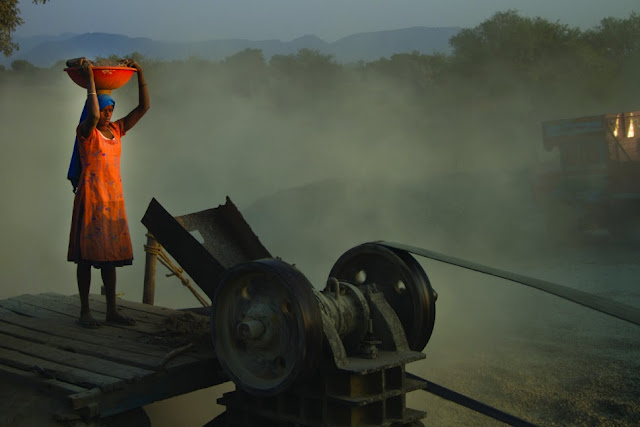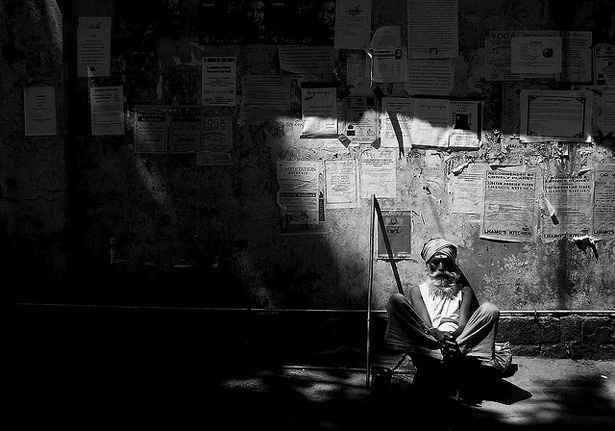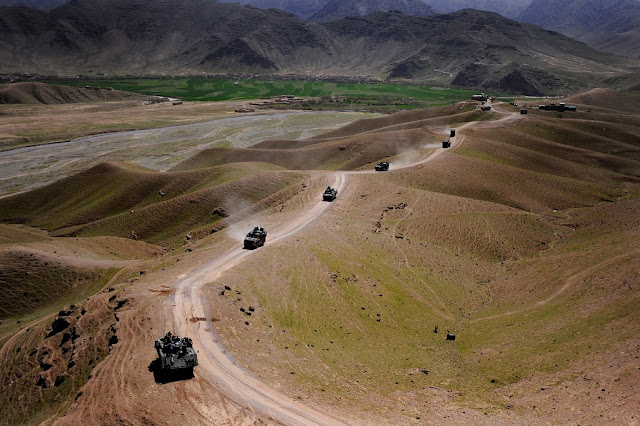-
Rare Earths Wake-Up, Aid Shocks, and the “Securitization” Distraction
›October 8, 2010 // By Geoffrey D. DabelkoHere are some useful links to environment, population, and security work that recently crossed my desk.
• China’s willingness to cut exports of rare earth elements to Japan over its East China Sea dispute woke up the larger world to the heavy dependency on China for supplying these key inputs into the modern (and green, in particular) industrial economy. Chinese attempts to take back their shot across the bow are bound to fail, as illustrated by U.S. Commerce Secretary Gary Locke’s call for the G20 to guarantee rare earth access, Wednesday at the Wilson Center.
• The National Geographic headline, “Replacing Oil Addiction With Metals Dependence?” raises another key long-term question, explored in detail on NSB in several previous posts.• “Aid Shocks Likely Cause Armed Conflict,” is the provocative title on a post from the new blog AidData. The post summarizes a forthcoming scholarly piece in the American Political Science Review that suggests cutting-off foreign assistance (what the author team calls an “aid shock”) significantly increases the likelihood of violent conflict.
• Dan Smith, Secretary-General of the UK-based NGO International Alert, has multiple nuggets in his latest riff, “From the UK gov’t, a good message on development and peace.” Like the Global Dashboard post I mentioned last week, Smith uses the recent speech by UK Development Secretary Andrew Mitchell as his foil. The MDGs aren’t the sum total of development and a new narrative is needed. “Securitization” is a distraction that should be put to rest, and integration and focus on conflict-affected countries are the centerpiece of a welcome new narrative coming out of London.
• Finally, Wilson Center President and Director Lee Hamilton is stepping down this fall after twelve years heading the Center. His time at the Center comes after 34 years as a Congressman from Indiana. Lee’s departure has engendered numerous profiles; this one in Foreign Policy is one of the best. -
U.S. v. China: The Global Battle for Hearts, Minds, and Resources
›September 22, 2010 // By Schuyler NullThis summer, Secretary Clinton gave a speech at the Association of Southeast Asian Nations (ASEAN) summit in Hanoi that Chinese Foreign Minister Yang Jiechi called “in effect an attack on China.” What did Clinton say that prompted such a direct response? She called for negotiations over the rights to resource extraction in the South China Sea to be multilateral rather than bilateral:
-
Fire in the Hole: A Look Inside India’s Hidden Resource War
›August 18, 2010 // By Schuyler Null -
The Conflict Potential of Climate Adaptation and Mitigation
›August 4, 2010 // By Schuyler Null“Climate change and our energy future are issues that are really front and center in our policy debates and public debates,” said ECSP Director Geoff Dabelko in this collection of interviews from New Security Beat’s Backdraft series. “One specific set of questions within this larger debate is about how climate change connects to a broader security set of questions. In that context we have a lot of questions and a lot of concerns – [and] potentially some opportunities.”
-
Landmark Law Takes Aim at the “Resource Curse”
›July 22, 2010 // By Schuyler NullBy signing the financial overhaul package on Wednesday, President Obama also enacted the first major U.S. government attempt to require transparency in the international oil, gas, and mineral trade, aimed at reducing the risk of “resource curse” scenarios that have plagued countries like Nigeria and the Democratic Republic of Congo.
The amendment, sponsored by Senators Bill Cardin and Richard Lugar, requires extractive companies registered with the SEC to publicly disclose their tax and revenue payments to foreign governments. The amendment singles out the DRC for additional scrutiny: companies trading in tin, coltan, wolframite, and gold – minerals found commonly in eastern Congo – will need to report whether they are sourcing from the DRC or its neighbors and disclose what steps they have taken to ensure that their supplies are conflict-free.
The international community will be eagerly watching the results of this effort. Can a U.S. law on conflict minerals reduce violence in the DRC’s complex civil war? I recently argued that while the legislation is a great initial effort, it will have little immediate impact on the violence and suffering in the country. In a recent interview with New Security Beat, EITI expert Jill Shankleman called the Cardin-Lugar bill “an important step” but pointed out that it only covers companies who are listed with the SEC and does not reduce the need for countries to enter into EITI.
Will this new law help Afghanistan – with its allegedly vast stores of valuable minerals – avoid the fate of the DRC? While some fear that corruption and lack of transparency may lead to conflict around the new Chinese contract to operate Afghanistan’s Aynak copper field, a recent U.S. Army War College paper argues that contrary to prevailing opinion, the Chinese approach to large-scale extractive investments could complement Western-led military stabilization efforts.
Photo Credit: “Wolframite” from the DRC, courtesy of flickr user Julien Harneis. -
DRC’s Conflict Minerals: Can U.S. Law Impact the Violence?
›July 13, 2010 // By Schuyler NullApple CEO Steve Jobs, in a personal email posted by Wired, recently tried to explain to a concerned iPhone customer the complexity of ensuring Apple’s devices do not use conflict minerals like those helping to fund the civil war in the Democratic Republic of Congo. However much one might be tempted to pile on Apple at the moment, Mr. Jobs is on to something with regard to the conflict minerals trade – expressing outrage and raising awareness of the problem is one thing but actually implementing an effective solution is quite another.
As finely articulated in a number of recent articles about conflict minerals in the DRC (see the New York Times, Guardian, and Foreign Policy for example), the Congo is, and has been for some time, a failed state.
Although a ceasefire was signed in 2003, fighting has continued in the far east of the country around North and South Kivu provinces, home to heavy deposits of tin, gold, coltan, and other minerals. The remote area is very diverse ethnically and has seen clashing between government troops and various militias from the Congo itself as well as encroachments by its neighbors Rwanda, Uganda, and Burundi. Referred to as “the Third World War” by many, there are by some accounts 23 different armed groups involved in the fighting, and accusations of massacres, rampant human rights abuses, extortion, and pillaging are common. According to the UN Special Representative on Sexual Violence in Conflict, “there is almost total impunity for rape in the Congo,” and a survey by the International Rescue Committee puts the estimated dead from preventable diseases, malnutrition, and conflict in the area at over five million over the past decade (or 45,000 deaths a month).
At a recent event in Washington, DC on this terrible conflict (see Natural Security for an excellent summary), DRC Ambassador Faida Mitifu expressed her hope to the audience and panel (including U.S. Under Secretary of State Robert Hormats) that they would not limit themselves to “just talking.” Hosts John Pendergast and Andrew Sullivan of the NGO Enough Project hope to address the demand side of Congo’s mineral trade by pushing Congress to pass the Conflict Minerals Trade Act, which would require U.S. companies to face independent audits to certify their products are conflict mineral-free.
But Laura Seay, of Texas in Africa and the Christian Science Monitor, is dubious of this proposal, pointing out that:Without the basic tools of public order in place and functioning as instruments of the public good in the DRC, the provisions of this bill are likely to work about as well as the Kimberley Process Certification Scheme does in weak states that lack functioning governmental institutions – which is to say, not at all.
The Kimberely Process (KP) is a certification scheme that is supposed to stem the flow of “blood diamonds” that support corrupt regimes and fuel human rights abuses. But the KP’s governing body has recently reached a crisis of action over whether or not to punish Zimbabwe for alleged abuses, with one diamond magnate even claiming, according to IRIN, that “corrupt governments have turned the KP on its head – instead of eliminating human rights violations, the KP is legitimizing them.”
The problem with international transparency schemes like the Kimberely Process, the proposed Conflict Minerals Act, or even EITI, is that at the very least, a functioning government – if not a beneficent one – is needed to enforce regulations at the source. In the DRC’s case, not only does the government have little to no authority over the affected areas, but the mining militias are smuggling their loot, on foot in some cases, directly into neighboring countries anyway. By the time they reach U.S. companies (if ever – Americans are not the only consumers in the world), conflict minerals have passed hands so many times that proving their provenance is next to impossible.
Then there is the question of whether or not cutting off the militias, rogue military officials, and government forces from conflict mineral monies would even end violence in the region in the first place. Certainly many armed groups gain a great deal from their illegal mining activities (as do some locals), but is it the root cause of their discontent? In the best case scenario where mining revenues are actually decreased, would that really convince the remnants of the Hutu Interahamwe, fleeing retribution from the now majority-Tutsi Rwandan government, to suddenly put down their weapons? How about the Mai Mai, who are fighting the Hutu incursion into their homeland?
I for one find that hard to believe. Stopping the conflict mineral trade from afar is very difficult, if not impossible, and even if we could end the trade, it would not necessarily stop the suffering. Illegal mining does play a large part in supporting rebel groups, but to address the human security problems that have so horrified the world, international attention ought to first be turned toward improving governance mechanisms in the Congo and rethinking the troubled UN peacekeeping mission (how about more involvement out of U.S. AFRICOM too?). The failure of the current UN mission is well documented, but withdrawing the largest peacekeeping force in the world in the face of continued violence, including the recent death of Congo’s most famous human rights activist under suspicious circumstances, seems more likely to cause harm than good.
Would passing the Conflict Minerals Act make Apple consumers feel better? Perhaps. But that’s not the point. Environmental security measures that prevent the DRC’s tremendous mineral wealth from being used to fund conflict can only make an impact if the government has some measure of accountable control over the area. To make a real difference in east Congo, human security must first be addressed directly and forcefully.
Sources: BBC, Christian Science Monitor, Daily Beast, Human Rights Watch, IPS News, IRIN News, International Rescue Committee, Enough Project, Foreign Policy, GlobalSecurity.org, Globe and Mail, New York Times, Share the World’s Resources, Southern Times, Times Online, UN, Wired.
Image Credit: “Minerals and Forests of the DRC” from ECSP Report 12, courtesy of Philippe Rekacewicz, Le Monde diplomatique, Paris, and Environment and Security Institute, The Hague, January 2003. -
India’s Maoists: South Asia’s “Other” Insurgency
›July 7, 2010 // By Schuyler Null
The Indian government’s battle with Maoist and tribal rebels – which affects 22 of India’s 35 states and territories, according to Foreign Policy and in 2009 killed more people than any year since 1971 – has been largely ignored in the West. That should change, as South Asia’s “other” insurgency, fomenting in the world’s largest democracy and a key U.S. partner, offers valuable lessons about the role of resource management and stable development in preventing conflict.
-
Interview With Wilson Center Scholar Jill Shankleman: Could Transparency Initiatives Mitigate the Resource Curse in Afghanistan?
›June 25, 2010 // By Schuyler Null
In the wake of The New York Times article detailing a potential mineral bonanza in Afghanistan, Senators Ben Cardin and Dick Lugar earlier this week published an op-ed in support of a bill that would create “an international standard for transparency in law” by requiring oil, gas, and mining industries to report amounts paid for drilling/mining rights in their SEC filings. A similar program, albeit a voluntary one, already exists – the Extractive Industries Transparency Initiative (EITI). The senators, however, raised questions about the ability of EITI to ensure transparency and accountability of payments for future mining rights to Afghanistan’s government. Joining EITI was a “good first step,” they say, “but too many countries and companies remain outside this system.”
Showing posts from category minerals.










